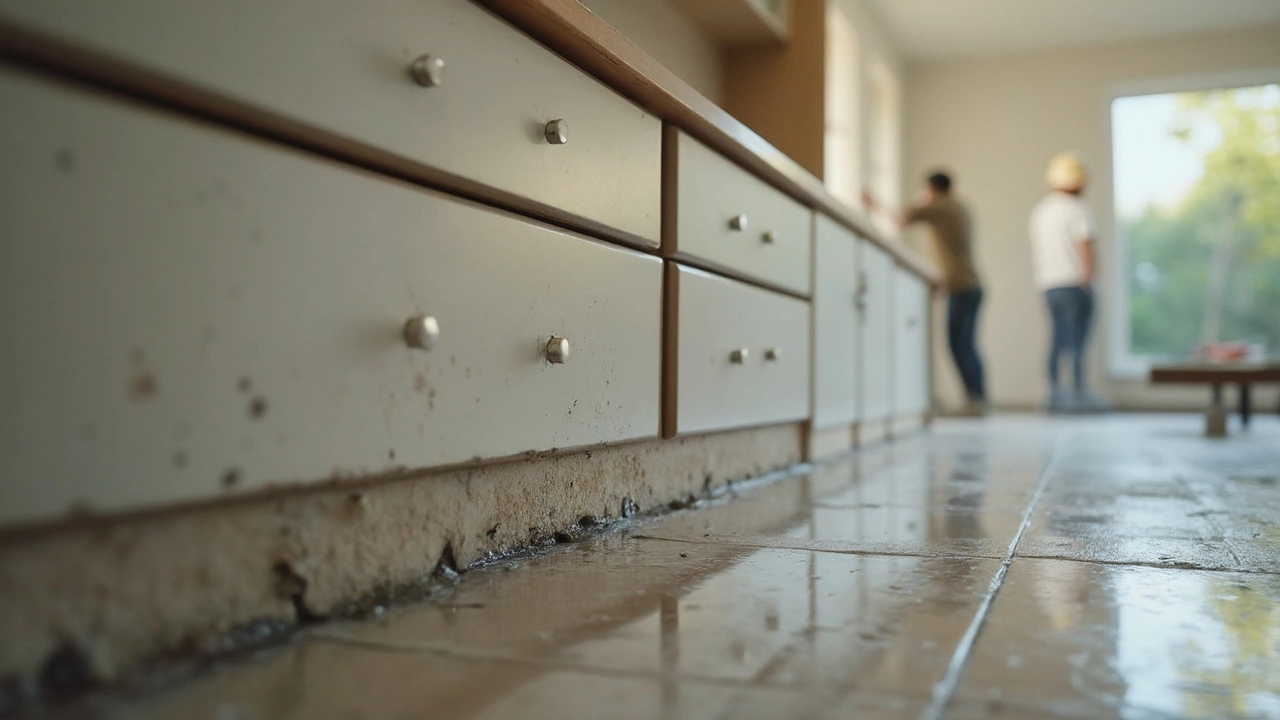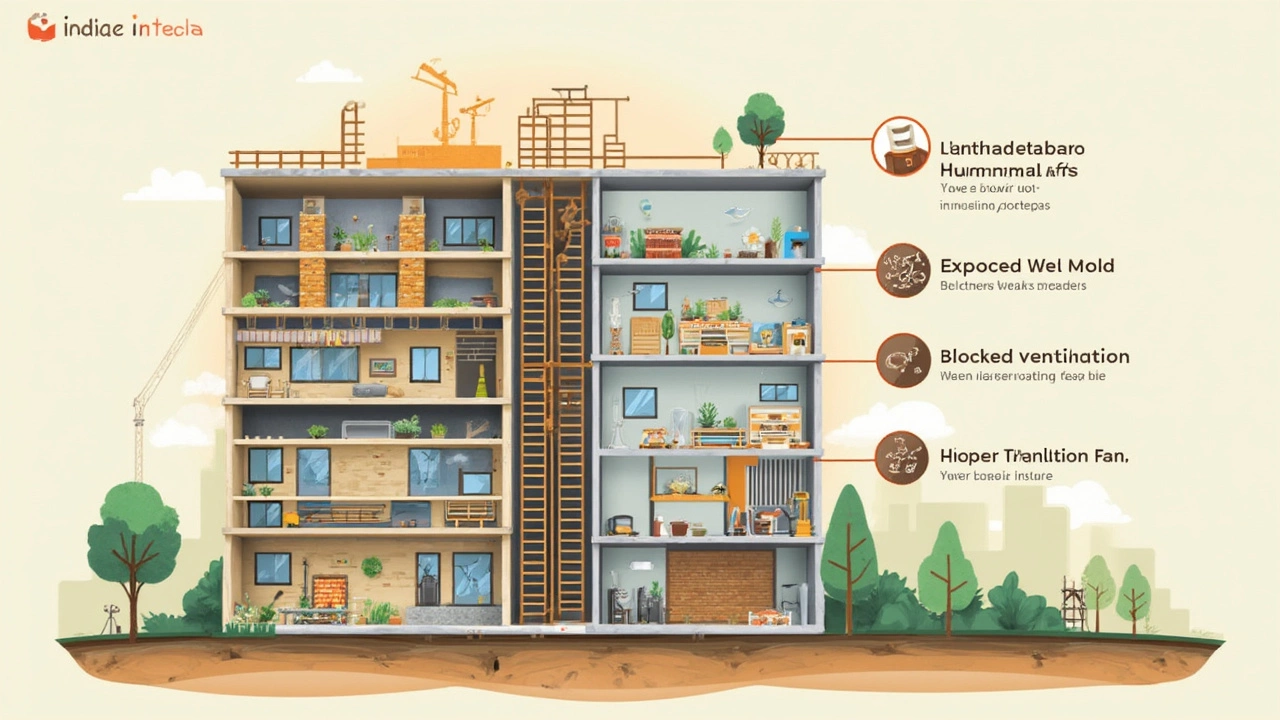There’s nothing like the smell of a brand-new house — unless you catch a whiff of something musty coming from the walls. Shocked? You’re not alone. Mold in new builds is a nasty surprise that’s a lot more common than you’d think.
You’d expect new homes to be squeaky clean, but here’s the thing: mold loves moisture, and there’s plenty of it trapped inside fresh construction. Builders rush to finish homes quickly, sometimes sealing up wet materials or skipping enough drying time. Even a few rainy days can leave plywood and drywall damp, and once that stuff gets walled in, there’s nowhere for the water to go.
If you spot condensation on brand-new windows, or find paint peeling near the baseboards, don’t shrug it off. These early signs can turn into ugly stains, or worse—black mold crawling up behind your cabinets. Mold doesn’t care about warranties or shiny appliances. All it needs is a little moisture and a few cozy corners, and it’s game on.
- The Sneaky Start: Where Mold Finds a Way
- It’s All About Moisture: Traps and Trouble Spots
- Shortcuts and Schedules: How Speedy Construction Creates Risks
- Warning Signs and Quick Fixes: Spotting Mold Early
- How to Keep Your New Home Mold-Free: Pro Tips
The Sneaky Start: Where Mold Finds a Way
Most folks are shocked to see mold show up in their brand-new homes, but the reality is it often starts growing before you even move in. Here’s what people miss: construction crews work through all sorts of weather. If the house frame or drywall gets soaked during rain and the materials aren’t allowed to dry properly, that moisture gets trapped inside the walls, floors, or ceilings — the perfect spot for mold to settle in and start multiplying.
Even brand-new new builds can have areas with high humidity simply because wet materials get sealed up too quickly. According to building science surveys, up to 60% of mold problems in new homes can be traced back to water infiltration during construction and not homeowner mistakes.
No house is totally safe from it. Mold spores are pretty much everywhere. The trick is they need moisture to go wild. When builders put up insulation or drywall before letting everything dry out, that’s like rolling out a welcome mat for mold. Sometimes, leaky pipes or poor sealing around windows and roofs let in even more water, giving mold more spots to grab on.
Most of the time, you won’t even know anything’s up. Mold isn’t always visible—it can be hiding in the walls, under floors, or in the attic. If you notice damp smells that won’t go away, especially after it rains, that’s a huge clue.
| Common Places Mold Starts in New Builds |
|---|
| Behind drywall and around insulation |
| Under flooring (like in basements or crawl spaces) |
| Near new plumbing pipes and water heaters |
| Inside attics and roof voids |
| Around window frames and door seals |
If you’re on the hunt for a new place or just moved in, don’t assume it’s too early for mold. Keep an eye—and a nose—out for trouble, even if everything looks shiny and new. Taking action early can save you a mountain of headaches later.
It’s All About Moisture: Traps and Trouble Spots
If you want to know why mold pops up so fast in new builds, just follow the water. Moisture is the real troublemaker, and new homes are full of spots where it likes to hide. Even after everything looks finished on the outside, wet materials and bad airflow can set the stage for a mold party underneath your floors or inside your walls.
One main culprit is construction moisture. Builders often use wet lumber or drywall that hasn’t had enough time to dry out, especially if there’s rain while the house is open. Once the walls get closed up, that trapped water can take months to fully escape—perfect for mold spores just waiting to grow.
Another big one is poor ventilation. If the attic, crawlspace, or even tight bathroom corners don’t get enough fresh air, humidity builds. Even a brand-new HVAC system won’t compensate if vents or exhaust fans are blocked or installed wrong. It just takes a little trapped steam from a shower or kitchen to get things started.
Watch for these common moisture traps in new homes:
- Window sills with condensation or leaky seals
- Basements and slabs that weren’t properly waterproofed
- Bathrooms without vent fans—or fans not vented outside
- Roof or wall cavities with missing insulation or poorly sealed joints
- HVAC ducts running through unsealed crawlspaces or attics
Check out this quick look at where moisture usually hangs out in new homes:
| Problem Area | Why It's Risky |
|---|---|
| Basements | Ground moisture rises if not properly sealed |
| Attics | Poor airflow traps humidity |
| Bathrooms | Frequent steam, fans often underpowered |
| Exterior Walls | Rainwater intrusion from gaps or bad flashing |
Catching moisture early is the number one way to stop mold from making itself at home. Extra time spent checking trouble spots now beats a pricey fix later.

Shortcuts and Schedules: How Speedy Construction Creates Risks
Builders hustle to finish new builds fast—especially in hot markets. This rush often means critical steps get skipped or rushed, creating a playground for mold. Tight schedules are good for profits, but not for drying wet materials. For example, if lumber or drywall goes in while it’s still damp, that moisture gets trapped inside the walls, just waiting to feed mold spores.
One real problem is poor scheduling after heavy rain. In some areas, crews don’t wait long enough for framing to dry before putting up insulation and drywall. A study from the Canadian Mortgage and Housing Corporation found that moisture trapped in wall cavities from fast builds is a leading cause of mold growth in new homes.
Another shortcut: sealing up the house before it’s fully dried out. Some roofers rush the job or install shingles while the roof deck is wet. It’s not just walls and roofs, either—unfinished basements and leaky windows from bad installs hold onto moisture too.
- Skipping or rushing the use of vapor barriers—the plastic sheets that keep water from seeping through walls—makes a bigger mess down the line.
- HVAC systems sometimes get turned on too soon, which just spreads moisture around and can push it right into the ducts.
- Builders sometimes store materials on damp ground, so they go in already moldy or soaked. Not ideal for a new build.
Take a look at this:
| Construction Step | Common Shortcut | Risk For Mold? |
|---|---|---|
| Drywall installation | No full drying time | High |
| Roofing | Shingles over wet decking | Very High |
| Painting | On damp surfaces | High |
| Window install | Poor sealant, rushing caulking | Medium |
If you’re buying a brand-new home, don’t just ask about the finishes. Ask what steps the builder takes to let things dry and who checks for leftover moisture. Quick builds can save cash upfront, but dealing with hidden mold in year one costs a whole lot more.
Warning Signs and Quick Fixes: Spotting Mold Early
Catching mold fast in new builds saves you money and prevents bigger headaches down the road. It’s not always in plain sight. So, what should you look for? Don’t just trust your eyes—trust your nose, too. A musty smell is a dead giveaway. Even if you don’t see black or green spots, a damp, earthy odor means you probably have mold hiding somewhere.
Here’s what you want to keep an eye (and nose) out for:
- Mystery stains on walls or ceilings, especially yellow or brown marks
- Paint bubbling, peeling, or cracking for no obvious reason
- Condensation gathering on windows, or wet spots on window sills
- Warped floors or doors sticking more than usual—these can be signs of trapped moisture
- Sudden allergy symptoms getting worse indoors, like sneezing or itchy eyes
If you find any of these signs, act fast. Don’t wait for the builder’s warranty period to run out. Try these quick fixes while you figure out if you need a pro:
- Dry out the area: Open windows, run fans, or crank up a dehumidifier. Mold needs moisture, so pull it out of the air.
- Clean small spots: Mix water with a little dish soap or vinegar and scrub away what you can see (wear gloves and a mask—it’s not worth risking your lungs).
- Check for leaks: Look under sinks, around toilets, and under appliances. Even a tiny drip can kickstart a mold colony.
- Cut back clutter: Mold loves hiding behind piles of stuff, especially cardboard boxes or old clothes left in a corner.
Sometimes, spotting mold early isn’t enough. New homes can hide icky surprises behind drywall or under flooring—especially if construction didn’t allow materials to dry completely. If your gut tells you there’s more mold than you can handle, call in a specialist. The cost now is nothing compared to tearing out half your kitchen later.
| Problem | Quick Action |
|---|---|
| Musty smell in room | Ventilate and use dehumidifier |
| Water stains on drywall | Find leak, dry area, clean spot |
| Condensation on windows | Increase airflow, lower humidity |
Trust your senses and be proactive. Mold in new builds isn’t just an old house problem, and fast action can mean the difference between a cheap fix and a gut-renovation.

How to Keep Your New Home Mold-Free: Pro Tips
Let’s get practical. Keeping your new build safe from mold is about staying ahead of moisture and knowing which areas need extra attention. The good news? A few simple habits and checks go a long way.
- Ventilation is key: Always run bathroom and kitchen exhaust fans when you’re cooking or showering. Humidity jumps fast indoors, and good airflow keeps surfaces dry. If your house feels stuffy, it’s a red flag.
- Check for leaks from day one: New pipes and seals sometimes shift as a building settles. Look under sinks and behind toilets for drips and puddles. Any wet patch can kick off the mold cycle.
- Use a dehumidifier: Especially in basements or crawl spaces. Keep indoor humidity below 55%. Modern dehumidifiers tell you the level at a glance.
- Don’t ignore condensation: If you get foggy windows or droplets on cold surfaces, wipe them down and check if your insulation or window seals need attention. Moisture left to sit is the enemy.
- Stay on top of minor water spills: If you mess up watering the plants or just mopped the kitchen, dry it up quickly. Even small puddles left for hours can breed mold.
- Monitor your attic and roof: After storms or heavy rains, peek into your attic. Roof leaks don’t always drip onto your pillow—they can soak insulation and timbers without you noticing for weeks.
Here’s a quick look at how different spots in the house compare for moisture risk:
| Area | Moisture Risk | Common Issues |
|---|---|---|
| Basement | High | Condensation, leaks, poor airflow |
| Bathroom | High | Poor venting, shower seepage |
| Kitchen | Medium | Steam from cooking, plumbing leaks |
| Attic | Medium | Roof leaks, blocked vents |
| Living room/Bedrooms | Low | Window condensation, spills |
If you ever spot a suspicious stain, act fast. Don’t just paint over it. Cut out the wet section, let it dry, and fix the leak. It might feel like overkill on a new build, but it saves you way more trouble later. Prevention always beats remediation. Want your home to stay fresh and safe? Make these checks second nature.



